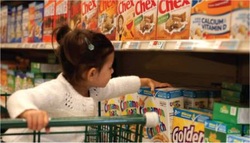The Supermarket

"Our basic need and desire for food has made the supermarket one of the great success stories of modern retailing. Making customers' visits as efficient and profitable for the store as possible has led to many technological advancements, such as bar coding and a scale that recognizes the type of produce placed on it.Wander the aisles with MODERN MARVELS® to explore the finely-engineered psychology of the supermarket, including store layout, lighting, music and aromas that trigger the appetite. Also, learn how organic grocers are carving out an increasingly large niche as a growing percentage of the public becomes interested in eating healthier foods..
"Discover just how far the modern market has come from the mom-and-pop corner store in THE SUPERMARKET." Quote from Modern Marvels - the Supermarket, by the History Channel.
Where does our food come from? In industrialized countries student will usually answer that questions with "Wal-Mart, or the grocery store." It was truly shocking to watch as Jamie Oliver displayed a wide array of fresh vegetables to a class of first graders, and not one child could identify even one vegetable!
This strand of Food and Culture will examine where food comes from and how it gets from the farm to the store. Here students will investigate packaging, transportation, marketing, architecture, technologies, and the evolution of the modern supermarket. This strand has natural connections to agriculture, environmental studies, water, biodiversity, gardening, psychology, chemistry, media literacy (from package design to advertising), financial literacy, emotional/social literacy, resource management, labor issues and waste management. Cultural studies will open students eyes as they learn the many different ways people around the world shop for their food. And, of course, nutrition and cooking!
"Discover just how far the modern market has come from the mom-and-pop corner store in THE SUPERMARKET." Quote from Modern Marvels - the Supermarket, by the History Channel.
Where does our food come from? In industrialized countries student will usually answer that questions with "Wal-Mart, or the grocery store." It was truly shocking to watch as Jamie Oliver displayed a wide array of fresh vegetables to a class of first graders, and not one child could identify even one vegetable!
This strand of Food and Culture will examine where food comes from and how it gets from the farm to the store. Here students will investigate packaging, transportation, marketing, architecture, technologies, and the evolution of the modern supermarket. This strand has natural connections to agriculture, environmental studies, water, biodiversity, gardening, psychology, chemistry, media literacy (from package design to advertising), financial literacy, emotional/social literacy, resource management, labor issues and waste management. Cultural studies will open students eyes as they learn the many different ways people around the world shop for their food. And, of course, nutrition and cooking!
Web Sites
Groceteria.com - a site about the history of the American supermarket, from the 1920s through the 1980s.
Supermarket
The National Food Exchange
SIC 5411 - Grocery Stores
Supermarket
The National Food Exchange
SIC 5411 - Grocery Stores
Books and Videos
The American Grocery Store - The Business Evolution of an Architectural Space - read it online here.
Modern Marvels - the Supermarket - excellent video by the History Channel!
Modern Marvels - the Supermarket - excellent video by the History Channel!
